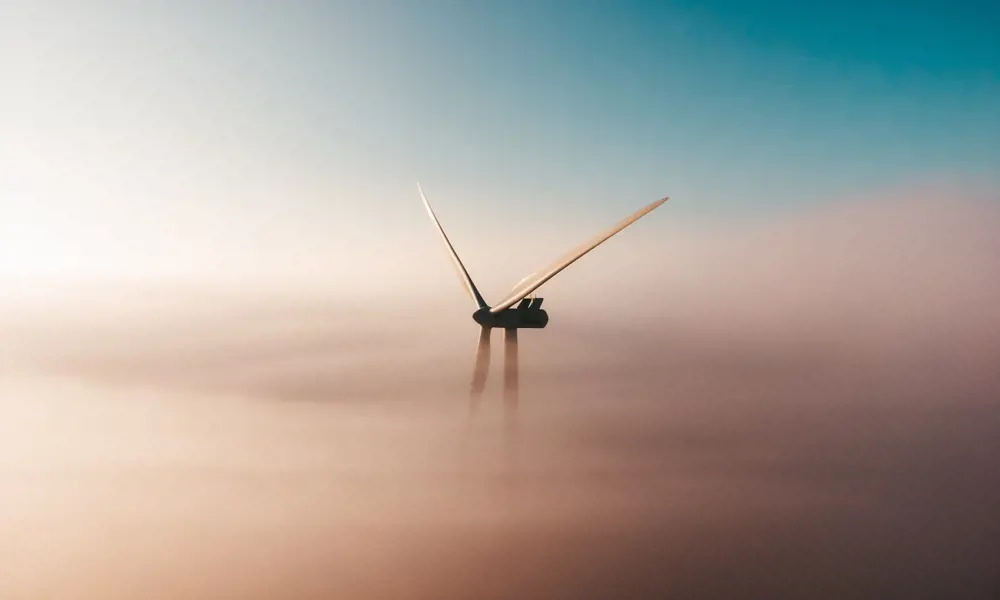
Breathing new life into wind turbine blades
Did you know?
🎡 Recycling wind blades
- Some of the longest wind turbine blades are longer than Big Ben lying on its side
- Thousands of blades are retired annually – all made from composite materials, which are currently difficult to recycle
- While chemical engineering may have the key to recyclable future blades, many sectors (including wind) are working on approaches to recycle current blades
In the 1990s, when the first wave of wind turbines was being installed, was there a plan of action as to what to do with them 25 years later, when they finished their working lives? Landfill would have been seen as one solution, and for the US that option is being used on a large scale. Around 8,000 wind turbine blades are retired in the US annually, with thousands being buried across the country each year. In the last few years, this problem has become more high-profile: one ‘wind turbine graveyard’ in Wyoming that plays host to 1,000 blades sparked a frenzy of media interest in alternative solutions to landfill.
There is a reluctance to go down the burial route in Europe, where 4,000 are being taken down annually. In June 2021, WindEurope, representing 400 wind energy organisations, called for a Europe-wide ban on landfilling decommissioned wind turbine blades by 2025. Such a ban is already in place in Austria, Germany, Finland, and the Netherlands, with other countries due to follow suit.
WindEurope’s aim is that a landfill ban will accelerate the development of recycling technologies for composite materials. The innovation endgame is to create a circular economy within the wind industry whereby all the resources that go into making the wind turbines can be reused, recycled, or recovered. For decades, that vision seemed a long way off, but in the last couple of years a few significant technological developments have been made.
The problem with recycling composites in turbine blades
Wind turbines are already 85 to 90% recyclable. Components contained within the tower and nacelle, including steel, copper, wire, and gearing, can all be recycled and reused. However, the wind turbine blades themselves are composites built to withstand hurricane-force winds. They are engineered to have high stiffness for optimum aerodynamics, low density to reduce gravitational forces and a long fatigue life, which make them difficult to compress or repurpose. Offshore blades are usually longer than onshore ones, with some stretching to over 115 metres – longer than a football pitch, or Big Ben lying on its side.
Most wind turbine blades are based on a laminate core material, usually balsa wood or high-density foam such as polyethylene terephthalate (PET). This is cast with a polymer resin matrix and reinforced with mostly glass and some carbon fibres. This creates a composite material – combining materials with different physical and chemical properties – that enable greater stiffness and reduced weight for the blades, as well as corrosion resistance. In addition, some electrical items are incorporated to prevent damage from lightning strikes (see schematic ‘Generic cross-section of a rotor blade’).
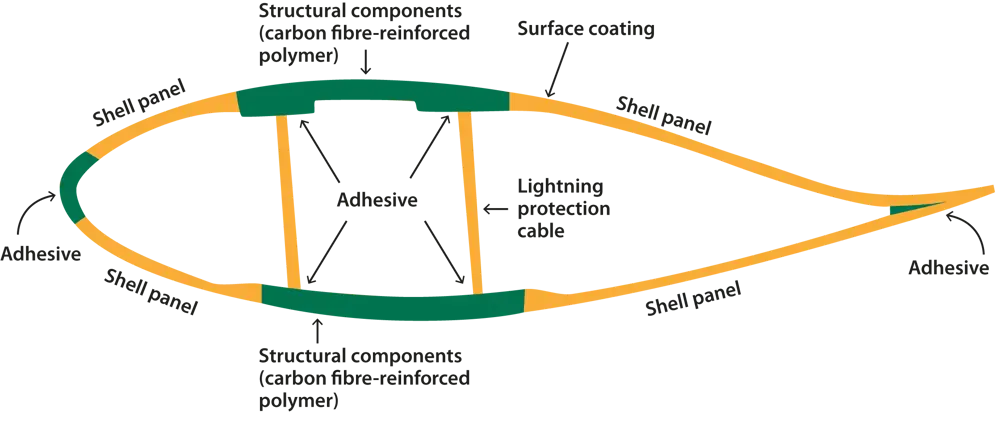
Generic cross-section of a wind turbine blade, showing its components. Materials vary depending on the manufacturer, but normally the shell panel (a ‘sandwich’-like core material) is made from balsa wood or a foam like PET, reinforced by sheets of glass fibre and cast in a polymer resin. Structural parts of the blade are made from carbon-reinforced polymer. A lightning protection cable is included, as well as adhesives to bind the components together, and coatings that provide protection from corrosion © WindEurope
It is because the turbine blades are made with these composites based on thermoset polymers that they are so difficult to break down or reuse at their end of life. During manufacture, thermoset polymers become cross-linked together within irreversible chemical bonds. This makes them resistant to high temperatures and remain in a permanent solid state once cooled.
WindEurope estimates that there is currently 2.5 million tonnes of composite material in use in the wind sector worldwide. And blade waste is only a fraction of the larger composite waste problem. By 2025, it is estimated that blade waste will make up 10% of all thermoset composite waste, with much of the rest coming from the automotive, aerospace and sports goods industries.
Sustainable waste management processes in Germany
Most blades being taken down from their turbines today are bonded with glass fibre (carbon fibres have been a late addition to blade strengthening). Today, German blades form the bulk of European blade decommissions. It is also in Germany – where direct landfilling of blades is banned – where one process has been developed that uses the plastic components for generating energy and the glass fibre as a raw material for making cement.
Sustainable waste management company Geocycle has developed and honed this process at LafargeHolcim’s cement plant in Lägerdorf, North Germany. The process starts at the wind farm, where blades are chopped into more manageable lengths. These are then taken to a preprocessing plant where they are shredded, with magnets extracting the metals. The remaining blade powder is mixed and bound with a humid substrate material consisting of other recycled items, including paper waste.
How can make use of old wind turbine blades?
✔️Different ways to process blades and how they are reused
- 🔥 Thermal (such as pyrolysis): High temperatures used to separate fibre from polymer matrix. Used for:
- Energy (breakdown of polymer into oils and waxes)
- Carbon fibres can be recovered, albeit at a slightly reduced strength
- ⚙️ Mechanical Grinding: Composites turned into a fine powder. Used for:
- Additives
- Cement kiln co-processing (as in Geocycle’s process)
- ♻️ Reprocessing: Includes recovering whole mats; or milling or chopping material and reusing it or compressing it into pellets. Used for:
- Reuse in thermoplastics for injection moulding (pellets)
- Additives with tailored electrical and thermal conductivity (milled fibre)
- Automotive industry (chopped fibre)
- 🧪 Chemical Solvolysis: Dissolving the polymer matrix with heated water or a chemical solvent. Used for:
- High-quality glass and carbon fibres produced (however, technology still being scaled up)
At Lägerdorf, the polymer matrix is recovered as thermal energy in the waste-to-energy plant. The mineral content, from the ground glass fibre, is used as a part substitute for the silica and carbon clay used to make cement. Using this process means that one tonne of blade waste enables a reduction of 110 kg of CO2 emissions and saves 460 kg of raw materials in cement production. In 2020, Geocycle processed 15,000 tonnes of composite waste, of which 10,000 tonnes were from wind turbine blades. The company is now looking to implement this cement co-processing, also known as the cement kiln route, in other European countries.
In 2020, Geocycle processed 15,000 tonnes of composite waste, of which 10,000 tonnes were from wind turbine blades.
Unfortunately, the cement route is only suitable for glass fibre-reinforced composites because of the health risks of grinding carbon fibre composites, which would produce asbestos-like fibres. Industry and academic innovation programmes worldwide are working on numerous other approaches, with various end uses. Of these, mechanical grinding is an effective, lowcost and low-energy approach for thermoset composites. The recycled products can be used as reinforcement or fillers, but there is also 40% material waste generated during grinding. It is not yet price-competitive, so at the moment, it is not a widely used option for blade disposal.
With pyrolysis, chopped up blades are incinerated at 500 to 600°C until the composite fibres separate from the polymer matrix in the oven. While the fibres can be reclaimed and reused with a slightly reduced strength, the polymer byproducts, such as syngas and oil, can be used as an energy source – for example to power combustion engines. However, the high investment and running costs mean that it is currently only economically viable for retrieving carbon fibres, as glass fibres degrade too much at the high temperatures used.
But despite all of this, new solutions are needed: in the UK, 90% of fibre-reinforced plastic waste was sent to landfill between 2018 and 2019. By 2025, there will be 25,000 tonnes of new blade waste every year, and that this amount will double by 2030.
Some projects have repurposed whole sections of blades as construction materials for playgrounds, bridges and roofs (see ‘Blades in public spaces’).
But despite all of this, new solutions are needed: in the UK, 90% of fibre-reinforced plastic waste was sent to landfill between 2018 and 2019. By 2025, there will be 25,000 tonnes of new blade waste every year, and that this amount will double by 2030.
Looking to the future, a potential game-changer is if the crosslinking of the chemical bonds in making these polymers could be reversed, making it significantly easier to extract carbon fibre intact. Siemens Gamesa, one of the world’s top three wind turbine manufacturers, has recently made this breakthrough.

Light trails from buses passing under the Wind Turbine Blade on display as part of the UK City of Culture 2017 in Kingston Upon Hull © Siemens Gamesa
Blades in public spaces
Some blade manufacturers have combined with artists and architects to creatively reuse blades for public spaces. In 2017, one 28 tonne, 75-metre blade was installed as a monumental sculpture in the heart of Hull for 11 weeks when it was the UK City of Culture. In Rotterdam, a children’s playground has been made from five discarded blades. Blades have also been used to construct bus stops, cycle sheds and public benches.
Altering resin composition to make recyclable blades
Siemens Gamesa launched the world’s first recyclable wind turbine blade in September 2021. The first six 81-metre blades were built in Denmark, and now more are being constructed in the company’s UK factory in Hull. Later in 2022, the giant blades will be installed at the RWE Kaskasi offshore wind farm in the North Sea.
Jonas Pagh-Jensen, Siemens Gamesa’s Environmental Health Specialist, has been closely involved with the project since 2018, helping it progress from being a research-based proposal to an accredited, commercially viable product.
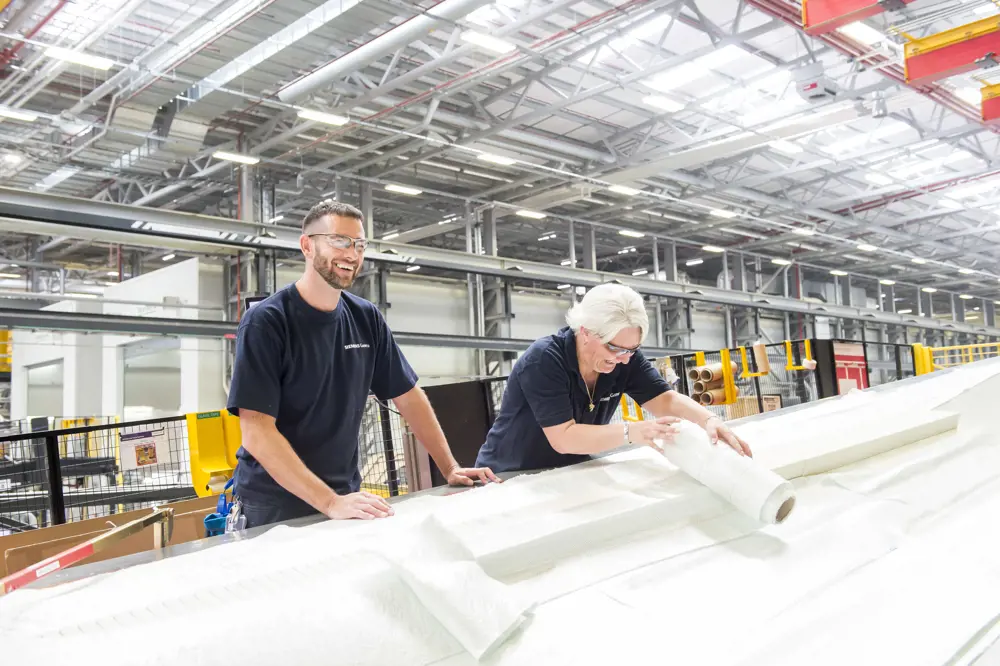
The assembly of the wind turbine blades at the Hull factory is done entirely by hand, with rolls of fibre shaped to create the composite structure that makes up the blades © Siemens Gamesa
Jonas says that to make the journey short, and to minimise changes to the manufacturing process, Siemens Gamesa worked closely with the materials science R&D team at the Aditya Birla Group, a partner manufacturer that produces chemicals, on changing the resin that binds all the components of a blade together. It did not seek to alter the design and build of its IntegralBlade – its flagship blade, cast in one piece from fibreglass-reinforced epoxy resin. Instead, the project set out to alter the durable thermoset resin that fuses the fibreglass, plastic, wood, and metal – usually rendering these components permanently inseparable.
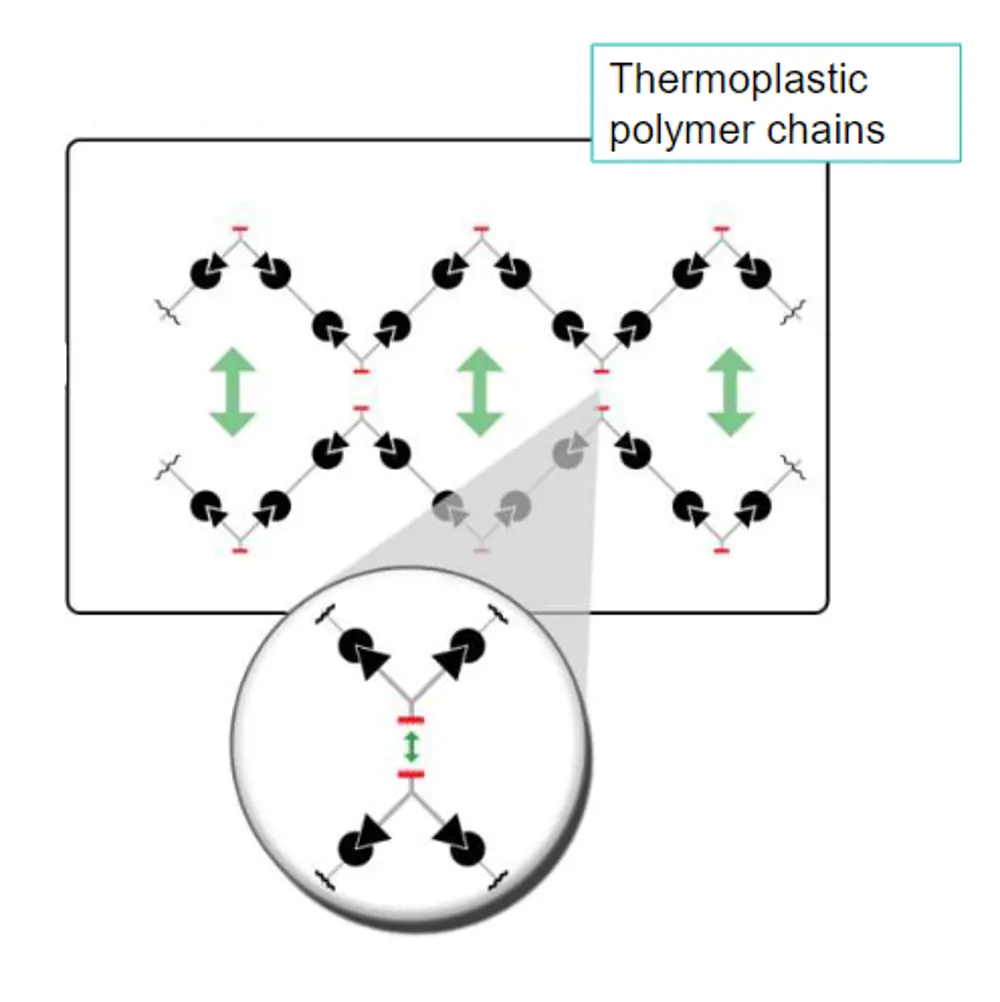
The RecyclableBlade’s resin has cleavage points that can be opened with a mildly heated acidic pH solution – thus breaking the cross-linked network. The resin dissolves and separates from the rest of the materials enabling all a blade’s constituent parts to be recycled © Siemens Gamesa
Aditya Birla’s testing facilities and labs worked on resin and recyclability options using the company’s existing Recyclamine technology. The new resin has a slower reactivity that improves processability. By enabling it to cure faster than existing materials, it cuts blade manufacturing times to about the same as ‘normal’ blade manufacturing times. As the blade manufacturing process is the same, then there is no increased implementation risk with the new resin system. The groundbreaking element of the resin is in the change in its chemical structure. Ordinarily, the polymer chains of the regular thermoset resin crosslink irreversibly when brought to high temperatures. In the new resin system, the polymer chains crosslink into a network with cleavage points that can be chemically opened in the right conditions.

A 62-metre-long blade made by the ZEBRA consortium, based on a recyclable thermoplastic resin made by Arkem © ZEBRA consortium
When the time comes for the RecyclableBlades to be decommissioned, they will be cut up and immersed for a few hours in a heated mild acidic solution. Jonas says that this is similar in strength to the “ones you make to pickle cucumbers to go with your burgers. The resin then dissolves and separates out material waste streams consisting of plastics, fibres and core materials.”
Because of the relatively low temperatures used to heat up the mild acids, the strength of the waste stream materials are not compromised, so have a high reusable value. The reclaimed plastics could be used for sporting goods or household appliances; while the carbon fibres will still be strong enough for applications such as storage tanks, skis, automotive or aviation industry uses. The glass fibres won’t be as strong, as their strength decreases owing to the loads that they will have carried over the lifetime of the blade. However, they could still be turned over to the car industry as filler material for doors and seating. They could even be reapplied with new fibres and made into new blades – completing a full blade-making circle.
Siemens Gamesa is not the only wind sector player that has come up with a solution to this problem. In early 2022, the ZEBRA (Zero wastE Blade ReseArch) consortium announced the making of a prototype blade using thermoplastic resin. The 62-metre blade will now undergo structural testing and a validation of its end-of-life recycling with the aim of reusing all of its components.
Recovering glass fibre components of discarded blades whilst increasing their strength
Many wind turbine blades based around the UK will reach the end of their 20 to 25 year working lives by the mid-2030s. Researchers within the Advanced Composites Group at the University of Strathclyde have been given a grant of £1.3 million by Innovate UK to find a way to recover and recycle the glass fibre components of discarded blades. Working with five industrial partners, who have contributed more than £700,000 to the project, the Strathclyde team will commercialise a new method that it has developed to separate glass fibre and resin components in composites.
“Retaining and redeploying the embodied energy in the fibres will be essential as we move to a more circular economy. These components can then be reprocessed, moulded and reused in industries such as automotive and construction.”
Ordinarily, the loss in strength and surface functionality during the recycling process diminishes the attraction of using recycled glass fibres. The Strathclyde researchers have developed a proprietary approach that uses a fluidised bed process and regenerative treatment to significantly increase the tensile strength of these fibres – by about 300%. Further work has established that improved recycled glass fibre strength and fibre–polymer adhesion can be achieved with a mixture of new regeneration treatments under development.
Dr Liu Yang, Head of the Advanced Composites Group and recipient of a Royal Academy of Engineering Industrial Fellowship, has said of the three-year project: “Retaining and redeploying the embodied energy in the fibres will be essential as we move to a more circular economy. These components can then be reprocessed, moulded and reused in industries such as automotive and construction.”
On the horizon for blades
There is growing pressure to extend the life of existing blades through maintenance and innovation to maximise their working potential. In Europe, it is increasingly becoming a requirement for blade manufacturers to outline how they will deal with end-of-life recycling before being allowed to start a wind power project.
However, it is not only a wind industry problem: blade waste represents just a fraction of all estimated thermoset composite waste. The relatively low volumes of composite blade waste make it difficult to build a dedicated blade recycling business based just on this waste stream.
Engagement from a variety of composite-using sectors, such as automotive and construction, will be required to develop cost-effective solutions.
Engagement from a variety of composite-using sectors, such as automotive and construction, will be required to develop cost-effective solutions. At least, and at last, there is now a momentum to increase recycling rates and deal with waste pollution. This impetus has been helped by waste legislation. There now seems to be an overwhelming public and business desire to increase resource efficiency and help develop a more circular economy. Finally, progress is being made that could spell an end to the ‘graveyards’ such as those in Wyoming.
***
This article has been adapted from "Breathing new life into wind turbines", which originally appeared in the print edition of Ingenia 91 (June 2022).
Contributors
Dominic Joyeux
Author
Jonas Pagh-Jensen completed a PhD in environmental engineering before working on the RecyclableBlade project at Siemens Gamesa as a Sustainability Specialist. He is now Head of Sustainability at Siemens Gamesa.
Keep up-to-date with Ingenia for free
SubscribeRelated content
Design & manufacturing
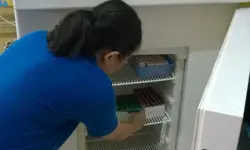
Super cool(er)
Welsh startup Sure Chill has developed a cooler that uses the properties of water to keep its contents cool for around 10 days without electricity. This is ideal for storing items such as vaccines where electricity sources are unreliable.

R&D investment makes good business sense
In just five years, Dr Ralf Speth FREng has presided over a revolution in design and manufacturing that has helped create a new family of engines and has overhauled Jaguar Land Rover (JLR) production facilities.
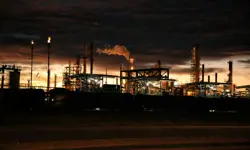
Steel can arise from the ashes of coal
Thousands of people were laid off in the UK steel industry in 2015 and there are pessimistic future forecasts. Professor Sridhar Seetharaman of the Warwick Manufacturing Group argues that smaller, flexible steel mills implementing new technology would better cope with fluctuating global trends.

Integrating metrology in business and academe
Professor Jane Jiang’s interest in measuring began when she worked on a bus production line in China. She found that the best way to improve quality, consistency and productivity was through metrology, the science of measurement. Today, she runs the UK’s largest metrology research group.
Other content from Ingenia
Quick read

- Environment & sustainability
- Opinion
A young engineer’s perspective on the good, the bad and the ugly of COP27

- Environment & sustainability
- Issue 95
How do we pay for net zero technologies?
Quick read

- Transport
- Mechanical
- How I got here
Electrifying trains and STEMAZING outreach

- Civil & structural
- Environment & sustainability
- Issue 95